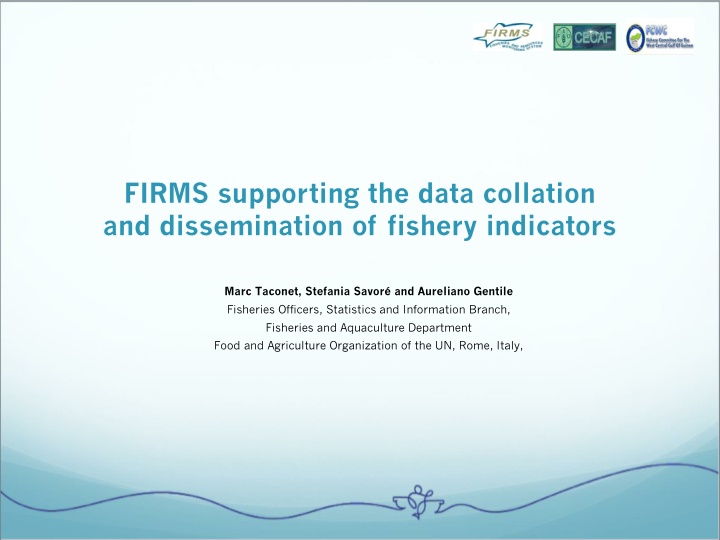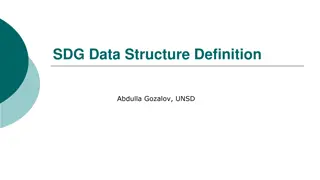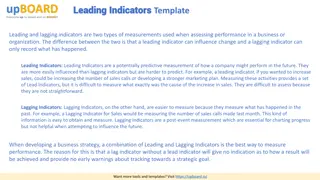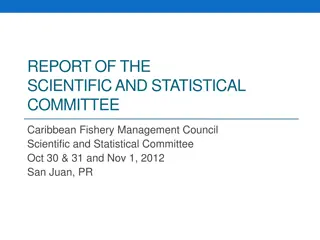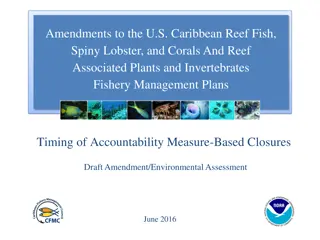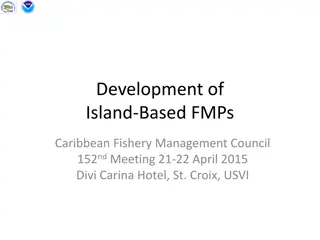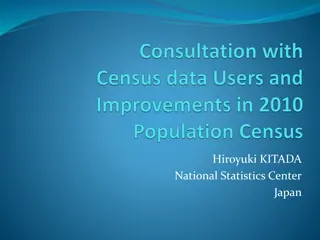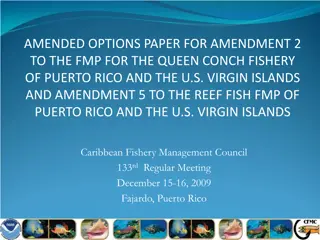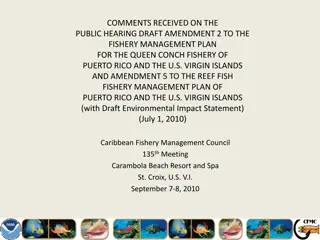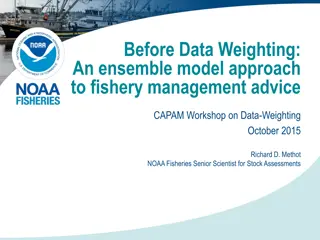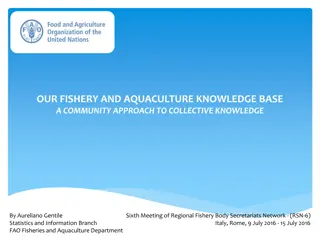FIRMS supporting the data collation and dissemination of fishery indicators
Supporting the data collation and dissemination of fishery indicators is crucial for monitoring and managing fisheries effectively. FAO plays a key role in collecting socio-economic data related to employment in the fishing industry, fishing fleets, consumption of fishery products, trade statistics, and more. This information is gathered annually through various methods such as questionnaires, national publications, and international databases, providing valuable insights into global fishery trends and patterns. The data collected by FAO enables informed decision-making and policy formulation to ensure the sustainability of fisheries and aquaculture practices worldwide.
Download Presentation

Please find below an Image/Link to download the presentation.
The content on the website is provided AS IS for your information and personal use only. It may not be sold, licensed, or shared on other websites without obtaining consent from the author.If you encounter any issues during the download, it is possible that the publisher has removed the file from their server.
You are allowed to download the files provided on this website for personal or commercial use, subject to the condition that they are used lawfully. All files are the property of their respective owners.
The content on the website is provided AS IS for your information and personal use only. It may not be sold, licensed, or shared on other websites without obtaining consent from the author.
E N D
Presentation Transcript
FIRMS supporting the data collation and dissemination of fishery indicators Marc Taconet, Stefania Savor and Aureliano Gentile Fisheries Officers, Statistics and Information Branch, Fisheries and Aquaculture Department Food and Agriculture Organization of the UN, Rome, Italy,
FAO and the collection of socio-economic data Employment Number of commercial and subsistence fishers and fish farmers from 1970. Annual via questionnaire. Separation of the number of workers according to the time devoted to fishing as an occupation (full-time, part-time, occasional). Number of people engaging in inland or marine waters, and commercial aquaculture. Disaggregation of employment data by gender.
FAO and the collection of socio-economic data Fishing fleets National annual statistics. Number and total tonnage of fish catching used in commercial, subsistence and artisanal fisheries are collected by size of vessel measured in gross register tons (GRT) or gross tons (GT) Data collected for 10 types of vessels defined in the International Standard Statistical Classification of Fishery Vessels (ISSCFV, currently under revision) Collection methods: directly from each country through a questionnaire and explanatory notes. national publications, international fishery magazines, FAO fishery country profiles, national fleet registers and Lloyd's Maritime Information Services database. The problems in obtaining the information prevent release of timely statistics.
FAO and the collection of socio-economic data Apparent consumption of fish and fishery product Annual statistics Supply/utilisation accounts (SUAs) for eight groups of primary fishery commodities and nine groups of processed products. Data on per caput fish food supplies are expressed in terms of quantity and, in terms of caloric value and protein and fat content. Information disseminated through FAOSTAT (http://www.fao.org/fishery/statistics/global-consumption/en) and FishStatJ (http://www.fao.org/fishery/statistics/software/fishstatj/en)
FAO and the collection of socio-economic data Fishery Commodities and Trade Annual production of fishery commodities. Imports and exports (including re- exports) of fishery commodities by country. Commodities in terms of volume and value. Summary statistics for apparent consumption of fish and fishery products. The disposition of world production and the value of production by capture fisheries and aquaculture, by major groups of species. The direction of trade for selected country groups. Information disseminated through FAOSTAT(http://www.fao.org/fishery/statistic s/global-consumption/en) and FishStatJ (http://www.fao.org/fishery/statistics/software /fishstatj/en)
Relevant socio-economic publications The following FAO publications provide fisheries data, including socio-economics information: FAO Yearbook of Fishery and Aquaculture Statistics: a compilation of statistical data on capture fisheries and aquaculture production, employment, commodities production and trade, apparent fish consumption and fishing fleets. The State of World Fisheries and Aquaculture (SOFIA): the flagship publication of the FAO Fisheries and Aquaculture Department. This premier advocacy document is published every two years to provide policy-makers, civil society and those whose livelihoods depend on the sector a comprehensive, objective and global view of capture fisheries and aquaculture, including associated policy issues.
FIRMS Indicators in support to socio-economic databases The FIRMS Inventory includes data models for many fishery indicators. This is expected to encourage collation of a wide variety of data, including socio-economic information provided by countries and in support of better management practices. Class Type Measure Exploitation Catch Catch Socioeconomic Effort Gross Value Added Nominal Effort Number of Ports Economic Performance Landed Volume Employment Landed Value Fishing Capacity Landed Average Price Fleet Size Landed Global Value Production International Market Global Value Participation Fleet Tonnage Utilization Fleet Power Number Vessels Number Fishermen Number Fishing Unit Trawling Hours Per Capita Consumption Domestic Human Consumption Shared in Animal Protein The provision of these indicators could support outlooks like SOFIA particularly where collation of data is not yet produced or made publically available. FIRMS fact sheets offer an easily accessible opportunity to make this data available, combining quantitative and qualitative information.
The FIRMS thematic approach Different thematic approaches are envisaged, according to the disciplinary viewpoint prevailing in the identification of fishery units when a fisheries inventory is compiled:
Fishing Activity Main fishery descriptors: Gear type Fishery area Seasonality Production descriptors Flag state Target and/or other species (associated, protected, discarded spp.)
Management Approach Main fishery descriptors: Jurisdiction descriptors Captured species Target and/or other species (associated, protected, discarded spp.) Fishery area
Production Approach Main fishery descriptors: Land base Type of production system Vessel type Flag state Fleet segment Fishers community Fishery area
Jurisdictional Approach Main fishery descriptors: Management body Area of competence Jurisdiction area (geographical) Enforcement authority
Access Rights Main fishery descriptors: Jurisdiction descriptors Production descriptors Fishing agreement
